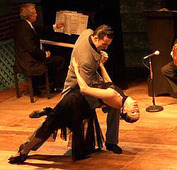|
TOTAL:
|
$0.00 |

|

|
|
Your On-Line Source for Latin Music Downloads!
|

|

Tango Project
This artist has albums available.
Contact us to license Latin music.
|

| Album Name | Preview | Style | Price | |
|---|---|---|---|---|
| Tango Project Vol.3 |
|
Tango | $10.99 |

|
| Tango Project Vol.2 |
|
Tango | $11.99 |

|
| Tango Project Vol.1 |
|
Tango | $11.99 |

|

 English: The dance originated as a merge of many different influences brought by immigrants from Europe in Buenos Aires combined with ancient African dance forms. The origins of the word is unknown though many think that it could find its origins in languages of Africa. The music derived from the fusion of various forms of music from Europe, Africa and the Americas. Jorge Luis Borges in "El idioma de los argentinos" writes:"Tango belongs to the Rio de la Plata and it is the son of Uruguayan "milonga" and grandson of the "habanera". The word Tango seems to have first been used in connection with the dance in the 1890s. Initially it was just one of the many dances, but it soon became popular throughout society, as theatres and street barrel organs spread it from the suburbs to the working-class slums, which were packed with hundreds of thousands of European immigrants.
English: The dance originated as a merge of many different influences brought by immigrants from Europe in Buenos Aires combined with ancient African dance forms. The origins of the word is unknown though many think that it could find its origins in languages of Africa. The music derived from the fusion of various forms of music from Europe, Africa and the Americas. Jorge Luis Borges in "El idioma de los argentinos" writes:"Tango belongs to the Rio de la Plata and it is the son of Uruguayan "milonga" and grandson of the "habanera". The word Tango seems to have first been used in connection with the dance in the 1890s. Initially it was just one of the many dances, but it soon became popular throughout society, as theatres and street barrel organs spread it from the suburbs to the working-class slums, which were packed with hundreds of thousands of European immigrants.
In the early years of the twentieth century, dancers and orchestras from Buenos Aires and Montevideo travelled to Europe, and the first European tango craze took place in Paris, soon followed by London, Berlin, and other capitals.
 Towards the end of 1913 it hit New York in the USA, and Finland. In the USA around 1911 the name "Tango" was often applied to dances in a 2/4 or 4/4 rhythm such as the one-step. The term was fashionable and did not indicate that tango steps would be used in the dance, although they might be. Tango music was sometimes played, but at a rather fast tempo. Instructors of the period would sometimes refer to this as a "North American Tango", versus the "Rio de la Plata Tango". By 1914 more authentic tango stylings were soon developed, along with some variations like Albert Newman's "Minuet" Tango.
Towards the end of 1913 it hit New York in the USA, and Finland. In the USA around 1911 the name "Tango" was often applied to dances in a 2/4 or 4/4 rhythm such as the one-step. The term was fashionable and did not indicate that tango steps would be used in the dance, although they might be. Tango music was sometimes played, but at a rather fast tempo. Instructors of the period would sometimes refer to this as a "North American Tango", versus the "Rio de la Plata Tango". By 1914 more authentic tango stylings were soon developed, along with some variations like Albert Newman's "Minuet" Tango.
In Argentina, the onset in 1929 of the Great Depression, and restrictions introduced after the overthrow of the Hipólito Yrigoyen government in 1930 caused Tango to decline. Its fortunes were reversed as tango again became widely fashionable and a matter of national pride under the government of Juan Perón. Tango declined again in the 1950s with economic depression and as the military dictatorships banned public gatherings, followed by the popularity of Rock and Roll. The dance lived on in smaller venues until its revival in the 1983's following the opening in Paris of the show Tango Argentino created by Claudio Segovia & Hector Orezzoli. This show made a revolution worldwide, and people everywhere started taking tango lessons.
In 1990, dancers Miguel Angel Zotto and Milena Plebs founded the "Tango X 2" Company , generating novel spectacles and increasing interest among younger people. They created a style that recovers the traditional tango of the milongas, renews it and places it as central element in its creations, doing an archeological search of the diverse styles of the tango.
 At the end of 1998 Milena Plebs dissociated herself of this company to initiate a road of personal investigation of diverse facets of tango dance.
At the end of 1998 Milena Plebs dissociated herself of this company to initiate a road of personal investigation of diverse facets of tango dance.
Español: El tango es un estilo musical y una danza rioplatense, propia de las ciudades de Buenos Aires, Rosario y Montevideo, de naturaleza netamente urbana y renombre internacional. Musicalmente tiene forma binaria y compás de cuatro por ocho, es clásicamente interpretado mediante orquesta típica o sexteto y reconoce al bandoneón como su instrumento esencial. La coreografía, diseñada a partir del abrazo de la pareja, es sumamente sensual y compleja. Las letras están compuestas con base a un argot local llamado lunfardo y suelen expresar las tristezas, especialmente «en las cosas del amor», que sienten el hombre y la mujer de pueblo, circunstancia que lo emparenta con el blues. Enrique Santos Discépolo, uno de sus máximos poetas, definió al tango como «un pensamiento triste que se baila».